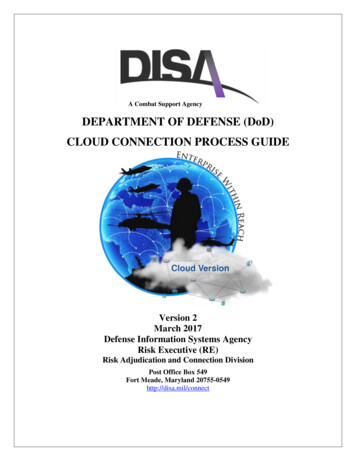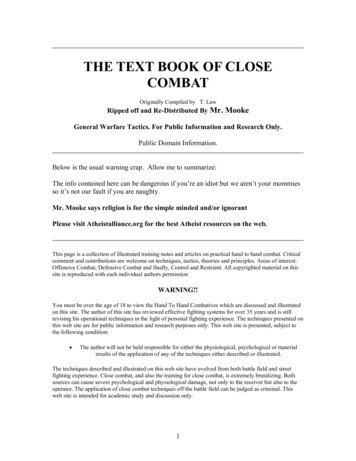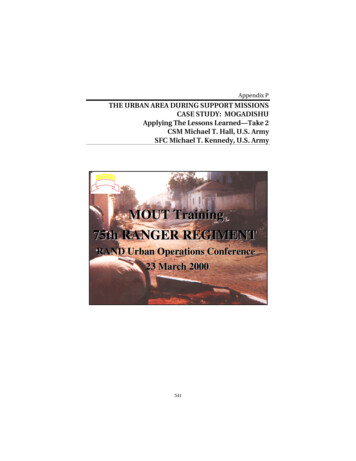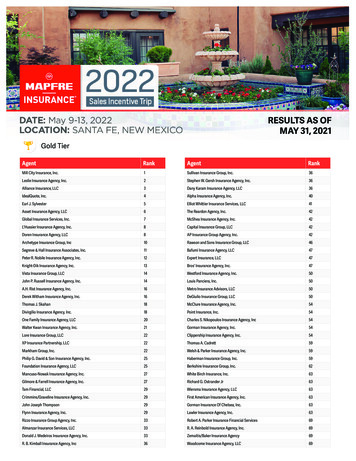
Transcription
A Combat Support AgencyDEPARTMENT OF DEFENSE (DoD)CLOUD CONNECTION PROCESS GUIDEVersion 2March 2017Defense Information Systems AgencyRisk Executive (RE)Risk Adjudication and Connection DivisionPost Office Box 549Fort Meade, Maryland 20755-0549http://disa.mil/connect
DoD Cloud Connection Process GuideThis page intentionally left blank
DoD Cloud Connection Process GuideEXECUTIVE SUMMARYThe Cloud Connection Process Guide (Cloud CPG) expands the Defense Information SystemsNetwork Connection Process Guide (DISN CPG) to include guidance for Department of Defense(DoD) connection and use of Cloud computing services. The goal of the Cloud CPG is to help aCloud Service Provider (CSP) navigate the DoD’s process for connecting a Cloud ServiceProvider-Cloud Service Offering (CSP-CSO) to the DISN and make it available for use by DoDMission Owners. The Cloud CPG also helps a DoD Component 1 Mission Owner to connect toan authorized CSP-CSO and “on-board” (or implement) a DoD Cloud Information TechnologyProject (C-ITP) in accordance with DoD cloud policy.Section 1 of this guide provides an introduction and overview of the DoD Cloud ComputingEnvironment and associated terms used within the DoD Cloud Community. Section 2 providesguidance to CSPs and their DoD Sponsors for registering and connecting Information ImpactLevels 2, 4, and 5 CSP-CSOs to the DISN. Section 3 provides guidance to DoD Mission Ownersfor registering and opening a connection to an authorized CSP-CSO. Appendix H providesguidance for Classified (Information Impact Level 6) cloud connections.Nothing in this Cloud CPG is intended or designed to usurp or impede: a DoD Component’sauthorities to develop and implement its own compliant cloud strategies under Title 10; or anAuthorizing Official’s (AO) authorities under DoD Instruction (DoDI) 8500.01 (ref a) and DoDI8510.01 (ref b). In addition, nothing in this Cloud CPG alters or supersedes the existingauthorities and policies of the Director of National Intelligence (DNI) regarding the protection ofsensitive compartmented information (SCI), as directed by Executive Order 12333 and otherlaws and regulations.This release of the Cloud CPG reflects the evolution of the DoD cloud strategy. This documentincorporates the lessons learned and process insights from “cloud pilots” and various otherefforts. DISA will update this guide to comply with DoD CIO Memo, Updated Guidance on theAcquisition and Use of Commercial Cloud Computing Services (ref c), and the DoD CloudComputing Security Requirements Guide (Cloud SRG) (ref d). 2Please send your improvement comments directly to the DISA Connection Approval Office(CAO) at disa.meade.ns.mbx.ucao@mail.mil or disa.meade.ns.mbx.ccao@mail.mil and theDISA Cloud Services Support Office (DISA CSSO) at e instructions in this guide are effective immediately and publically available from the DISAwebsite at http://disa.mil/computing/cloud-services.1 The term “Components” collectively refers to OSD; the Military Departments; the Office of the Chairman of the Joint Chiefs ofStaff (CJCS) and the Joint Staff; the Combatant Commands; the Office of the Inspector General of the DoD; the DefenseAgencies, the DoD Field Activities; and all other organizational entities within the DoD.2 The DoD Cloud Computing Security Requirements Guide (Cloud SRG (ref d)) and related documents are at:http://iase.disa.mil/cloud security/Pages/index.aspxVersion 2iMarch 2017
DoD Cloud Connection Process GuideSIGNATURE PAGEApproved by:HEIN.MATTHEW.A.1101454327Digitally signed byHEIN.MATTHEW.A.1101454327DN: c US, o U.S. Government, ou DoD,ou PKI, ou DISA,cn HEIN.MATTHEW.A.1101454327Date: 2017.03.10 07:50:36 -05'00'10 March 2017DateMatthew A. HeinChief, Risk Adjudication and Connection DivisionVersion 2iiMarch 2017
DoD Cloud Connection Process GuideREVISION HISTORYDISA will review and update this document as needed. The revision history table documentssignificant changes to this guide.VersionDate1.021 Aug 2015Revisions Initial Release The emphasis was registration of CSPs and DoD C- ITPsin the DISA SNAP Database (ref e)1.0122 Sep 2015 Incorporated guidance from the DISA Document ReleaseGroup (DRG) to authorize public release2.0March 2017 Approved draft for formal review and comment Expands the scope from a DISA to a DoD Cloud ProcessGuide Reorganizes the material by major cloud processes: CSPCSO Registration and Connection, Sustaining, ServicesDiscontinuation; and, C-ITP Registration and Connection,Sustainment, and Service Discontinuation Presents processes in a step-by-step fashion Adds appendices for DoD Component Cloud Connection,Cloud Points of Contact, Classified C-ITP Registration,and documentation requirementsPlease send comments on the DoD Cloud CPG to the DISA CSSO at sion 2iiiMarch 2017
DoD Cloud Connection Process GuideTABLE OF CONTENTSEXECUTIVE SUMMARY . iSIGNATURE PAGE . iiREVISION HISTORY . iiiTABLE OF CONTENTS . ivLIST OF FIGURES . vLIST OF TABLES . v: INTRODUCTION . 1Purpose . 1Authority . 1General Guidance . 1Applicability . 1Background . 1Key Concepts and Terminology . 2User Connections to a CSP-CSOs . 7Cloud Registration and Connection Processes . 8. CLOUD SERVICE PROVIDER-CLOUD SERVICE OFFERING (CSP-CSO)REGISTRATION AND CONNECTION LIFE CYCLE . 11Introduction . 11Obtain a DoD PA for a CSP-CSO . 12Update Pertinent Repositories with CSP-CSO Information . 15Issue CATC or Acknowledgement of Registration. . 15Connect CSP-CSO to the Appropriate Gateway . 15CSP-CSO Connection Sustainment and Maintenance . 19Discontinue CSP-CSO Service . 22CSP-CSO Connection Process Checklist . 23CLOUD INFORMATION TECHNOLOGY PROJECT REGISTRATION AND CONNECTIONPROCESS . 27Introduction Cloud Information Technology Project (C-ITP) Registration and Connection 27Complete a DoD Cloud IT Project Initial Contact Form. 28Determine Initial C-ITP Prioritization for Connection to a CSP-CSO. . 28Determine if the CSP-CSO has a DoD PA. . 28Complete Registration of the C-ITP in DISA SNAP . 29Connect the C-ITP to an Authorized CSP-CSO Via an Appropriate Gateway . 32On-board the C-ITP to an Authorized CSP-CSO . 34C-ITP Connection Sustainment and Maintenance Process . 36Discontinue C-ITP Service. . 38C-ITP Registration and Connection Process Checklist . 39APPENDIX A: REFERENCES . 43APPENDIX B: PROCEDURES FOR CONNECTING A CSP-CSO TO A DoD COMPONENT BCAP . 47APPENDIX C: EXCEPTIONS TO COMMERCIAL CLOUD POLICY . 49APPENDIX D: CLOUD POINTS OF CONTACT . 51APPENDIX E: ACRONYMS . 55APPENDIX F: DEFINITIONS. 57APPENDIX G: RESPONSIBILITIES . 71Version 2ivMarch 2017
DoD Cloud Connection Process GuideAPPENDIX H: CLASSIFIED (INFORMATION IMPACT LEVEL 6) C-ITP REGISTRATION ANDCONNECTION PROCESS . 73APPENDIX I: SAMPLE OF AN IT TOPOLOGY DIAGRAM . 75APPENDIX J: INFORMATION REQUIREMENTS FOR CLOUD REGISTRATIONS AND CONNECTIONREQUESTS . 77APPENDIX K: CONSENT TO MONITOR AGREEMENT (SAMPLE). 81LIST OF FIGURESFigure 1:Figure 2:Figure 3:Figure 4:Figure 5:Figure 6:Figure 7:Figure 8:Figure 9:Figure 10:Figure 11:Figure 12:Figure 13:Figure 14:Figure 15:On-Premise and Off-Premise CSP-CSO . 6Information Exchanges between Users and CSP-CSOs . 8Cloud Registration and Connection Processes . 9CSP-CSO Registration and Connection . 11Connect CSP-CSO to the Appropriate Gateway . 16CSP-CSO Connection to the DISA Enterprise BCAP . 17Provisioning the CSP-CSO Connection to the DISA Enterprise BCAP. 18CSP-CSO Connection Sustainment and Maintenance Process . 20CSP-CSO Discontinue Service Process . 22C-ITP Registration and Connection . 27Process to Obtain a DISA SNAP Account . 29Connect the C-ITP to an Authorized CSP-CSO Via the Appropriate Gateway . 32C-ITP Connection Sustainment and Maintenance Process . 36C-ITP Discontinue Service . 39Sample Connectivity Topology Diagram . 75LIST OF TABLESTable 1:Table 2:Table 3:Table 4:Table 5:Table 6:Table 7:CSP-CSO Registration and Connection Process Checklist . 23DoD Mandated Cloud Computing Standards . 35Mission Cyberspace Defense Service Provider Contacts . 38C-ITP Registration and Connection Process Checklist. 40DoD CIO-Approved Component Cloud BCAP Points of Contact . 47DoD Component Cloud Migration Office Points of Contact . 51DISA Cloud Computing Team Points of Contact . 52Version 2vMarch 2017
DoD Cloud Connection Process GuideThis page intentionally left blankVersion 2viMarch 2017
DoD Cloud Connection Process Guide.: INTRODUCTIONPurposeThe Cloud CPG provides guidance, points of contact, and processes for a Cloud Service Provider(CSP) to connect a Cloud Service Provider-Cloud Service Offering (CSP-CSO) to the DISN andto make the CSP-CSO available for use by DoD Mission Owners. The guide also providesguidance for a Mission Owner to register and open a connection to an authorized CSP-CSO and“on-board” (or implement) a Cloud Information Technology Project (C-ITP) within anauthorized CSP-CSO.AuthorityThe Cloud Connection Process Guide (CPG) derives its authority from the same sources as theDISN Connection Process Guide (DISN CPG) (ref f) . Further, the DoD CIO Memo, UpdatedGuidance on the Acquisition and Use of Commercial Cloud Computing Services (ref c)establishes authorities and guidance for Commercial Cloud Computing Services. Finally, theDoD Cloud SRG (ref d) outlines the security controls and requirements necessary for usingcloud-based solutions within the DoD and states that the DoD Cloud CPG definesresponsibilities needed to establish and maintain connections between CSP-CSOs andDoD C-ITPs.General GuidanceThe Cloud CPG is a living document that will continue to evolve as connection processes arerefined and as additional cloud computing services become available. This version of the CloudCPG focuses on processes for connecting CSP-CSOs and DoD C-ITPs via the DISN. DISA willintegrate the Cloud CPG into future versions of the DISN CPG (ref f). Additional informationabout DISA enterprise cloud computing services is at http://www.disa.mil/Computing/CloudServices.Use the DoD Cloud CPG to help get through the connection process. However, beforeemploying this guide, always check for the current version at website: http://disa.mil/connect.ApplicabilityThis guide applies to all Mission Owners and Cloud Service Providers involved in using oroffering cloud computing services.BackgroundIn the current political, economic, and technological landscape, information technology (IT) willcontinue to provide extensive and ever‐increasing capabilities while consuming fewer resources.With the increase of both state‐sponsored and independent cyber threats, the DoD recognizes thegrowing importance of leading a strong and secure presence in cyberspace while responding tothe need for continued budgetary constraints and stricter financial oversight. As a result, theDepartment must transform the way in which it acquires, operates, and manages its IT in order torealize increased efficiency, effectiveness, and security (ref g).Version 21March 2017
DoD Cloud Connection Process GuideThe Department has begun this transformation by establishing a set of initiatives aimed atachieving improved mission effectiveness and cybersecurity in a reengineered informationinfrastructure. The result of this new effort will be the Joint Information Environment (JIE),which delivers faster, better-informed collaboration and decisions enabled by secure, seamlessaccess to information regardless of computing device or location.The DoD cloud computing environment is a key component to enable the Department to achieveJIE end state of an agile, secure, and cost effective service environment that can rapidly respondto changing mission needs. Cloud computing will enable the Department to: consolidate andshare commodity IT functions resulting in a more efficient use of resources; enhance Warfightermobility through device and location independence; provide on‐demand secure global access tomission data and enterprise services; and provide increased opportunity for rapid applicationdevelopment and reuse of applications acquired by other organizations.The Department has specific cloud computing challenges that require careful adoptionconsiderations, especially in areas of cybersecurity, continuity of operations, informationassurance (IA), and resilience. To help meet these challenges, the Department is leveraging theFederal Risk and Authorization Management Program (FedRAMP) (ref h) which serves as theminimum security baseline for DoD and provides a standardized approach to securityassessment, authorization, and continuous monitoring focused on enabling secure cloudcomputing products and services. DoD Components may host DoD Unclassified DoDinformation that is publically releasable on FedRAMP approved cloud computing services thathave a DoD Provisional Authorization (PA) as described in this document and the DoD CloudSRG (ref d).For more sensitive DoD unclassified data or IT Projects, DoD established the FedRAMP concept for leveraging the work done as part of FedRAMP assessment by adding specificsecurity controls and requirements necessary to meet and assure DoD’s critical missionrequirements as specified in the DoD Cloud SRG (ref d).Key Concepts and Terminology 3This document uses the following terms defined in DoD, CNSS, and NIST publications 4 relatedto DoD cloud computing.Assessor (aka Auditor) a party accredited to conduct independent assessment of cloudcomputing services, information system operations, performance, and security of the cloudimplementation.Boundary Cloud Access Point (BCAP) establishes a protected boundary between the DISN anda CSP-CSO. A BCAP will provide the capability to detect and prevent a cyber-attack fromreaching the DODIN. The BCAP Functional Requirements Document (FRD) (ref i) describesthe architecture of a DoD-approved BCAP. The DoD CIO must approve a DoD ComponentBCAP in accordance with procedures in Appendix C.Carrier – provides connectivity and transport of cloud computing services from providers toMission Owners (e.g., DISN).3 See NIST Special Publication, NIST SP 800-145 online at http://dx.doi.org/10.6028/NIST.SP.800-1454 NIST Cloud Computing Related Documentation online at ion 22March 2017
DoD Cloud Connection Process GuideCloud Service Offering (CSO): a Cloud Service Provider’s product or service. A CSOmay be a combination of multiple product/service offerings (e.g., Microsoft O-365 andAzure) and it can be based on any of the Cloud Deployment Models or Cloud ServiceModels (see below).Cloud Service Provider (aka Cloud Provider): an organization that provides cloudcomputing services – a CSP can be a business, a DoD Component, or another FederalDepartment or Agency.Cloud IT Project (C-ITP): a Mission Owner’s project that implements a machine,software application, or information service within one or more authorized CSP-CSOsand is registered in DISA SNAP (ref e) using the same project name the Mission Ownergave the C-ITP in the SNaP-IT and DITPR databases.Connectivity/Transport – The DISN (NIPRNet, SIPRNet)Deployment Models 5: A cloud computing system may be deployed privately or hostedon the premises of a cloud customer, may be shared among a limited number of trustedpartners, may be hosted by a third party, or may be a publically accessible service, thatis., a public cloud. The different deployment models present a number of tradeoffs inhow customers can control their resources, and the scale, cost, and availability ofresources (ref j). Private cloud. The cloud infrastructure is provisioned for exclusive use by asingle organization comprising multiple Mission Owners (e.g., business units). Itmay be owned, managed, and operated by the organization, a third party, or somecombination of them, and it may exist On-Premise or Off-Premise. Community Cloud. The cloud infrastructure is provisioned for exclusive use by aspecific community of Mission Owners from organizations that have sharedconcerns (e.g., mission, security requirements, policy, and complianceconsiderations). It may be owned, managed, and operated by one or more of theorganizations in the community, a third party, or some combination of them, andit may exist on or Off-Premises. Public cloud. The cloud infrastructure is provisioned for open use by the generalpublic. It may be owned, managed, and operated by a business, academic, orgovernment organization, or some combination of them. It exists on the premisesof the cloud provider. Hybrid cloud. The cloud infrastructure is a composition of two or more distinctcloud infrastructures (private, community, or public) that remain unique entities,but are bound together by standardized or proprietary technology that enables dataand application portability (e.g., cloud bursting for load balancing betweenclouds)."5 See NIST Special Publication, 800-146 for a Cloud Computing synopsis, recommendations, and terminology online pecialpublication800-146.pdfVersion 23March 2017
DoD Cloud Connection Process GuideDoD Assessor A DoD organization that leverages any existing Joint Assessment Board(JAB), Federal Agency, or DoD Self-Assessed PA and assesses CSP-CSOs forcompliance with FedRAMP requirements as stipulated in the DoD Cloud SRG (ref d)(e.g., DISA Cloud Assessment Team, DoD Component Cloud Assessor).DoD Sponsor: DoD Component responsible for ensuring the connection or CSP-CSOhas a valid DoD mission essential requirement, is properly maintained, resourced andsecure throughout the cloud connection’s lifecycle. The DoD Sponsor and DoD MissionOwner can be one in the same. The responsibilities of DoD sponsors are defined inseveral OSD and Joint Staff issuances and are summarized in the DoD CIO Summary ofDoD Sponsor Responsibilities for Mission Partner Connections to the DefenseInformation Systems Network (DISN), Memorandum, 14 August 2012Information Impact Levels: Information Impact Levels are defined by potential impactof an event resulting in the loss of confidentiality, integrity, or availability of data,systems or networks. See Section 3 of the DoD Cloud SRG (ref d) for details: Information Impact Level 2 - includes all data cleared for public release, as wellas some DoD private unclassified information not designated as ControlledUnclassified Information (CUI) or critical mission data, but the informationrequires some minimal level of access control. Information Impact Level 4 - accommodates CUI or other mission critical datathat a law, regulation, or Government-wide policy requires, or specificallypermits, an agency to handle by means of safeguarding or dissemination controls. Information Impact Level 5 - accommodates CUI that requires a higher level ofprotection than that afforded by Level 4 as deemed necessary by the informationowner, public law, or other government regulations. Level 5 also supportsunclassified National Security Systems (NSSs). Information Impact Level 6 - accommodates information that has beendetermined: (i) pursuant to Executive Order 13526, Classified National SecurityInformation (December 29, 2009), or any predecessor Order, to be classifiednational security information; or (ii) pursuant to the Atomic Energy Act of 1954,as amended, (P.L. 83-703) to be Restricted Data (RD).Internet Access Point. An IAP establishes a protected boundary between the NIPRNetand the public Internet. An IAP has capabilities to detect and prevent a cyber-attack onthe NIPRNet from the Internet.Mission Owner (aka Cloud Consumer): - Person or organization that maintains abusiness relationship and uses (or intends to use) authorized CSP-CSOs.On-Premise and Off-Premise CSP-CSO - Figure 1 illustrates how CSP-CSOs connectto the DISN when operating within a non-DoD facility (Off-Premise) or when operatingwithin a DoD facility (On-Premise 6) . On-Premise CSP-CSOs connect to the DISN via6 DoD Cloud SRG (ref d): CSP Infrastructure (dedicated to DoD) located inside the Base/Post/Camp/Station (B/C/P/S) “fenceline” (i.e., On-Premise) connects via an Internal CAP (ICAP). The architecture of ICAPs may vary and may leverageexisting capabilities such as the cybersecurity stack protecting a DoD Data center today or may be a Joint Regional SecurityVersion 24March 2017
DoD Cloud Connection Process GuideInternal CAPs (ICAPs). Off-Premise CSP-CSOs used for publically releasable data(Information Impact Level 2) usually connect to the Internet and interoperate with userson the NIPRNet via a NIPRNet Internet Access Point (IAP). Off-Premise CSP-CSOsused for Sensitive Data (Information Impact Levels 4 or 5) connect to the NIPRNetthrough a DoD CIO-approved BCAP such as the DISA Enterprise BCAP or a DoDComponent BCAP (e.g., the Navy BCAP) in accordance with the DoD CloudSRG (ref d). Each CAP must implement boundary protections as defined in the DoD CloudSRG (ref d) and the DoD Secure Cloud Computing Architecture (SCCA) FunctionalRequirements (FR) (ref k) to detect and prevent a cyber-attack from reaching the DODIN.As illustrated in Figure 1: All CSP-CSOs and Mission Owner C-ITPS must be registered in the DISA SNAPsystem (ref e) in accordance with DoD policy (ref c) and this guide. Information Impact Level 4 and 5 CSP-CSOs that connect via the DISA BCAPmust also have a Cloud Approval to Connect (CATC) issued by DISA. Information Impact Level 4 or 5 C-ITPs that connect via a DISA BCAP must alsohave a Cloud Permission to Connect (CPTC) issued by DISA. Since On-premise CSP-CSO’s connect to the NIPRNet via an ICAP, they musthave an Authorization to Operate (ATO) obtained pursuant to DoDI 8510.01(ref b) and a NIPRNet Approval to Connect (ATC) obtained in accordance withthe DISN CPG (ref f) A CATC is not required for an On-Premise CSP-CSO.IAPs and CAPs may integrate with pre-existing and emerging DODIN capabilities such as theNIPRNet De-Militarized Zone (DMZ) and the Joint Regional Security Stack (JRSS) to providean additional layer of security functionality necessary to defend against threats from using theCSP.Service Models 7: A cloud can provide access to software applications such as email oroffice productivity tools (the Software as a Service, or SaaS, service model), or canprovide an environment for customers to use to build and operate their own software (thePlatform as a Service, or PaaS, service model), or can provide network access totraditional computing resources such as processing power and storage (the Infrastructureas a Service, or IaaS, service model). The different service models have differentstrengths and are suitable for different customers and mission objectives. (ref j) Cloud Software as a Service (SaaS). The capability provided to the MissionOwner is to use the provider’s applications running on a cloud infrastructure. Theapplications are accessible from various client devices through a thin clientinterface such as a Web browser (e.g., Web-based email), or a program interface.The Mission Owner does not manage or control the underlying cloudinfrastructure including network, servers, operating systems, storage, or evenindividual application capabilities, with the possible exception of limited userspecific application configuration settings.Stack (JRSS). On the other hand, an ICAP may have special capabilities to support specific missions, CSP types(commercial or DoD), or cloud services.7 See NIST SP 800-146, (ref j)Version 25March 2017
DoD Cloud Connection Process GuideFigure 1: On-Premise and Off-Premise CSP-CSO Version 2Cloud Platform as a Service (PaaS). Provides the Mission Owner the capabilityto deploy onto the cloud infrastructure the Mission Owner’s applications createdusing programming languages and tools supported by the provider. The MissionOwner does not manage or control the underlying cloud infrastructure includingnetwork, servers, operating systems, or storage, but has control over the deployedapplications and possibly application hosting environment configurations.Cloud Infrastructure as a Service (IaaS). The capability provided to the MissionOwner is to provision processing, storage, networks, and other fundamentalcomputing resources where the Mission Owner is able to deploy and run arbitrarysoftware, which can include operating systems and applications. The MissionOwner does not manage or control the underlying cloud infrastructure but hascontrol over operating systems, storage, deployed applications; and possiblylimited control of select networking components (e.g., host firewalls).6March 2017
DoD Cloud Connection
(DoD) connection and use of Cloud computing services. The goal of the Cloud CPG is to help a Cloud Service Provider (CSP) navigate the DoD's process for connecting a Cloud Service Provider-Cloud Service Offering (CSP-CSO) to the DISN and make it available for use by DoD Mission Owners. The Cloud CPG also helps a DoD Component











